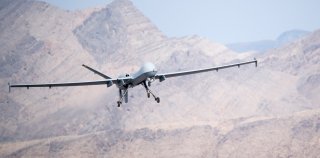The War in Ukraine Heightens U.S. Marines' Focus on Drones
Though the lessons to learn are myriad, an especially important one is the utility of small armed drones in spotting and striking dismounted troops or hidden vehicles.
In recognition of the threat armed unmanned aerial vehicles (UAVs) pose to troops on the battlefield, the Marine Corps is reckoning with how it will counter them.
The U.S. Marine Corps Program Executive Officer Land Systems is fielding a system called the Installation-Counter small Unmanned Aircraft Systems, or I-CsUAS. Composed of several tower components, the system will identify and track small UAVs to determine their point of origin and destroy them.
Though the Marine Corps already fields a similar counter-UAV system, the I-CsUAS adds machine learning and artificial intelligence into the mix and lowers the workload to the Marines operating the system—and the need for a counter-UAV system is great.
“Use your imagination of how much damage and chaos could be done by these small commercial off-the-shelf drones by attacking or otherwise harassing domestic Marine Corps installations,” Maj. Kyle Yakopovich said in a Marine Corps statement. “That's why we're doing this—to protect those assets and to enable the warfighter to do what the warfighter should be doing, which is keeping his focus oriented toward the enemy.”
I-CsUAS will allow the Marine Corps to effectively counter small unmanned aerial systems, like the kinds of commercially-available drones that can relatively easily be repurposed to carry munitions. The Marine Corps release explained that I-CsUAS “also provides detection, tracking and identification capabilities.”
“The Marine Corps, and DOD in general, required the capability to defend against sUAS years ago,” said Don Kelley, program manager for Ground-Based Air Defense at PEO Land Systems. Kelley added that “the threat of sUAS is only proliferating every day. The bottom line is, we need to provide this capability to our Marines as rapidly as possible.”
While the war in Ukraine continues to rage in the country’s east, pundits, talking heads, and armchair tacticians have rushed to draw conclusions from Europe’s most significant war in eighty years. Though the lessons to learn are myriad, one considerable lesson is the utility of small armed drones in spotting and striking dismounted troops and entrenched or hidden vehicles.
“These small commercial off-the-shelf drones—they're everywhere,” Marine Maj. Kyle Yakopovich said, explaining the technology’s ubiquitousness.
“You can't walk into a park without seeing them, and our enemies know how to use them. If you follow the news you can read articles about these drones being used as weapons of war in places like Ukraine, and those drones are capable of doing similar damage here at home. We're delivering these systems to CONUS locations and defending certain assets aboard those installations that have been deemed critical to national security,” Yakopovich added.
With no end to the war in Ukraine in sight, the Marine Corps is drawing lessons and adapting to counter twenty-first-century challenges.
Caleb Larson is a multimedia journalist and defense writer with the National Interest. A graduate of UCLA, he also holds a Master of Public Policy and lives in Berlin. He covers the intersection of conflict, security, and technology, focusing on American foreign policy, European security, and German society for both print and radio. Follow him on Twitter @calebmlarson.
Image: DVIDS

